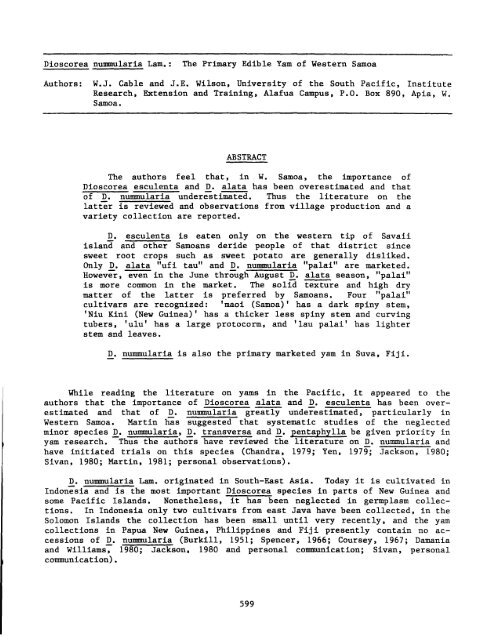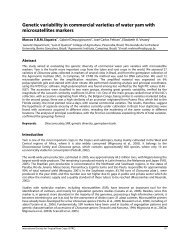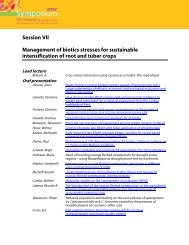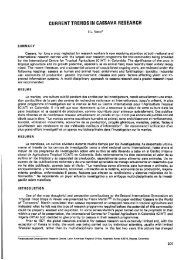Dioscorea nummularia Lam.: The Primary Edible Yam of Western ...
Dioscorea nummularia Lam.: The Primary Edible Yam of Western ...
Dioscorea nummularia Lam.: The Primary Edible Yam of Western ...
Create successful ePaper yourself
Turn your PDF publications into a flip-book with our unique Google optimized e-Paper software.
In the Solomon Islands D. nUDmlularia is locally called "karausu" and<br />
"puutiko." Eight cultivars from Guadalcanal have been recorded as 'uvi matua',<br />
'uvi vatu', 'uvi chamba' , chavuli', 'kaipuchi " 'ngoti hila', 'ngoti tambu ni<br />
bela' and 'sambina'. <strong>The</strong>se were largely found in the interior but with some in<br />
the west and at Longgu. Vines <strong>of</strong> these cultivars were generally many (10-20),<br />
with spines ranging from large and many to very few. Tubers varied in number and<br />
shape, some being round in cross-section, others square, generally deeply placed,<br />
although one cultivar was reported to produce shallow tubers. One cultivar produced<br />
small tubers within the first year but most required three or four years to<br />
produce a reasonable yield and most produced tubers with hard flesh although one<br />
cultivar typically had s<strong>of</strong>t flesh and tubers rotted easily (Barrau, 1956; Tedder<br />
and Tedder, 1974).<br />
On Anuta, a Polynesian outlier island in the Solomon Islands, D. <strong>nummularia</strong><br />
was mapped in central and eastern parts <strong>of</strong> agricultural zone III. It was called<br />
either "uporoi" or IITaumakoll, the former after Upolu, W. Samoa and the latter<br />
after a neigh-boring outlier. <strong>The</strong> tubers produced were illustrated as large.<br />
round and irregularly shaped. In contrast, D. alata and D. esculenta were mapped<br />
in only one area in zone VI with small plantS-and tubers (Yen and Gordon, 1973.)<br />
In Vanuatu, D. <strong>nummularia</strong> is called "pangoll and IIloopitiko", the latter being<br />
similar to the IIpuutiko" name used in the Solomon Islands. On Ponape, Federated<br />
states <strong>of</strong> Micronesia, D. flabellifolia Pro and Burk. reported in the literature to<br />
grow in the mountains and to be used during famine is most probably D. <strong>nummularia</strong><br />
cultivar llkap nair" or "kapin-air". D. <strong>nummularia</strong> variety IIsepll reported from yap<br />
appears to have a corrugated leaf like D. bulbifera (Glassman, 1952; Sasuke, 1953;<br />
Barrau, 1956; personal observation.) --<br />
In Fiji D. <strong>nummularia</strong> is called IIrauva (-dua)", "tivoli ll , "tikau" or "san<br />
shue ll in Cantonese, while in the Lau islands <strong>of</strong> eastern Fiji it is locally called<br />
"tchivoli", a name similar to one from the Solomon Islands. Generally it grows<br />
below 500 m elevation. It has been reported to be rare (less than 2%) in Suva<br />
home gardens as compared to 2-9% for D. alata, but in the Suva market it is definitely<br />
more important than D. alata. In 1975 and 1976 D. <strong>nummularia</strong> was<br />
recorded during 33 <strong>of</strong> the 35 market surveys with a mean abundance score <strong>of</strong> nearly<br />
3 out <strong>of</strong> a maximum <strong>of</strong> 4 (very abundant). Although it was available year-round,<br />
tubers were most abundant in the months April through November. One Saturday in<br />
November 1981 the senior author observed that yams in the Suva market were almost<br />
exclusively D. <strong>nummularia</strong> with cultivar IItivoli ll dominating. Only one Chinese<br />
merchant waS- selling D. alata "uvi" which was sprouting and spoiling. On<br />
Vanuabalavu island in the Lau group, wild "tivoli ll and IItikau ll yams were reported<br />
as common in the 1920s and 1030s, but have almost disappeared today due to<br />
extensive clearing <strong>of</strong> the forests (Barrau, 1956, 1961a; Thaman, 1976/1977, 1978a;<br />
Thaman and Ba, 1979; Smith, 1979; personal observations).<br />
In tonga cultivars "ufi fisi", IIngu ll and IItuaata" commonly found in cooperative<br />
yam gardens on Tongatapu may be D. <strong>nummularia</strong> but this species has not been<br />
reported from Vavau in northern Tonga (Prain and Burkill, 1959; Thaman, 1978b).<br />
"Ufi parai ll is the name given to D. nUDmlularia on Rarotonga and on Niue it is<br />
called by a similar name lIuhi palai".-- On the latter it has been reported to be<br />
scarce and to produce several long, slender, white tubers (Barrau, 1956).<br />
601
Data from market surveys conducted in Apia for the first week in each month<br />
<strong>of</strong> 1979 except January indicated that yams are only a minor cash crop in western<br />
Samoa. Each week total weight sold <strong>of</strong> the staple carbohydrates including taro,<br />
green bananas, Alocasia sp., breadfruit, yams and husked coconuts ranged from<br />
about 110 to 210 tonnes, whereas the maximum sale <strong>of</strong> yams reached only 0.3 tonnes<br />
in the two months August and December. Data for yams included both D. alata and<br />
D. <strong>nummularia</strong> but sale <strong>of</strong> the former is significant only in August during the<br />
cool, dry season when this species becomes dormant and sheds its leaves. At other<br />
times <strong>of</strong> the year D. alata is unpalatable and D. <strong>nummularia</strong> is the only species in<br />
the market. D. eSculenta (Lour.) Burk. "ufilei" is not marketed. It is now<br />
found only in-the driest Falealupo district on the western-most tip <strong>of</strong> Savaii.<br />
Most Samoans deride those from that district for eating the sweet tubers <strong>of</strong><br />
"ufilei" since sweet tasting root crops such as sweet potato are generally disliked.<br />
Likewise E.. pentaphylla L. "pilita", also called "lena" on Tutuila, is<br />
rare (Pratt, 1911; Setchell, 1924; Christophersen, 1935; Parham, 1972; Economic<br />
Analysis and Planning Division, 1979a-d; Leuluai J. W., personal communication;<br />
personal observations).<br />
In American as well as western Samoa villages "palai" are normally planted in<br />
mounds and trellised on poles to trees 5-6 m away. Each family generally has no<br />
more than twenty or so plants <strong>of</strong> the different "palai" cultivars. Stones <strong>of</strong>ten<br />
are used to surround the mounds and coconut husks and mulch may cap the top as<br />
well. Whole corms with several tuber initials or sections <strong>of</strong> individual upper<br />
tubers may be planted with or without pre-sprouting. Because <strong>of</strong> the effort in<br />
digging the relatively long tubers, harvest is usually delayed until after two<br />
years. In lithic soils the corm tops may by that time begin to protrude from the<br />
ground. Yield data are not available but one "palai niu kini" plant harvested<br />
from a home garden produced a 4-branched tuber weighing 21.2 kg. It descended 63<br />
cm into the soil and the dried remnants <strong>of</strong> the previous years's 4-branched tuber<br />
was attached to the same corm. This indicates that D. nummelaria is not perennial<br />
as sometimes reported (Merrick, 1977; Martin and Degras, 1978; personal observations)<br />
•<br />
<strong>The</strong>re is a Samoan legend concerning the "palai" (tivoli") yam in Fij 1. One<br />
<strong>of</strong> the numerous Sina married the king <strong>of</strong> Fiji. Her brother Pili went to visit her<br />
but hid in the bush being evidently doubtful <strong>of</strong> his brother-in-law's reception.<br />
He asked the birds and trees how he could arrange a meeting with his sister and<br />
the "palai" yam <strong>of</strong>fered to send out one <strong>of</strong> his "tala" vines to Sina's door. As<br />
Sina came out, her foot caught in the vine and since at that time there was a<br />
shortage <strong>of</strong> food in Fiji, Sina followed along the vine to find the tuber. <strong>The</strong>re<br />
she found her brother. Since "palai" yam is very long, Sina broke <strong>of</strong>f only a<br />
piece <strong>of</strong> it an returned home. Every day she returned to meet her brother and<br />
broke <strong>of</strong>f another piece <strong>of</strong> yam. As she had followed up (tuli) the broken-<strong>of</strong>f<br />
tuber (matanau), the tuber was called "tuli matanau". Hence repeated attempts at<br />
meetings or consultations to effect unity is referred to as "tuli matanau, Ie ufi<br />
a sina" (Tuli matanau, the yam <strong>of</strong> Sina) (Hiroa, 1930).<br />
Acknowledgement is made <strong>of</strong> Dr. M. Asghar and Mr. J. Breen who reviewed the<br />
manuscript, and <strong>of</strong> Mr. I. Sagaga who performed dry matter analyses.<br />
603
Onwueme, I.C. <strong>The</strong> Tropical Tuber Crops. Wiley, Chichester. 1978, 1-234.<br />
Parham, B.E.V. Plants <strong>of</strong> Samoa. DSIR Info. Sere 85, 1972, 135-137.<br />
Prain, P. and Burkill, I.H. An account <strong>of</strong> the genus <strong>Dioscorea</strong> in the East. Ann.<br />
Rev. Bot. Gdn., Calcutta 14, 1959, 367-372 and 427-528.<br />
Pratt, G. Pratt's Grammar and Dictionary <strong>of</strong> the Samoan Language. 1911, 241 and<br />
250.<br />
Sasuke, N. Breadfruit, yams and taros <strong>of</strong> Ponape Island. Proc. 7th Pac. Sci.<br />
Congr. 6, 1955, 159-170.<br />
Setchell, W.A. American Samoa. Dept. Marine Biol., Carnegie Inst., Wash., 20,<br />
1924, 77 and 106.<br />
Sivan, P. Evaluation <strong>of</strong> local yam (<strong>Dioscorea</strong> alata) varieties in Fiji. Fiji<br />
Agric. J. 42(2), 1980, 7-14.<br />
Smith, A.C. Flora Vitiensis Nova 1, 1979, 170-171.<br />
Spencer, J. E. Shifting cultivation in South East Asia. Univ. <strong>of</strong> Cal. Publ.<br />
Geogr. 19, 1966, 1-231.<br />
Tedder, M.M. and Tedder, J.L.O. <strong>Yam</strong>s: a description <strong>of</strong> their cultivation on Guadalcanal<br />
in the Solomon Islands. S. Pac. Commission Tech. Pap. 169, 3 and<br />
72-73.<br />
Thaman, R. R. Urban agriculture and home gardening in Fij i: a direct road to<br />
development and independence. Address to Fiji Soc., 1978a, 1-22.<br />
Cooperative yam gardens: an adaptation <strong>of</strong> a traditional agricultural<br />
system to serve the needs <strong>of</strong> the developing Tongan market economy. Ch. 8 In:<br />
Fisk, E.K. (ed.) <strong>The</strong> Adaptation <strong>of</strong> Traditional Agriculture: Socioeconomic<br />
problems <strong>of</strong> urbanization. Australian Natl. Univ. Devel. Studies Centre<br />
Monograph 11, 1978b, 116-126.<br />
Plant resources <strong>of</strong> the Suva Municipal Market, Fij 1. Ethnomed. 4.5,<br />
1976/77, 25-61.<br />
and Ba. T. Energy needs and forest resources <strong>of</strong> small islands. 10th NZ<br />
Geogr. Conf. 1975, 198-202.<br />
Yen, D.E. Food crops. In: Ward, R.G. and Proctor, A. (eds.) South Pacific Agriculture:<br />
choices and constraints. 1979, 197-234.<br />
and Gordon, J. Anuta: a Polynesian outlier in the Solomon Islands. Pac.<br />
Anthrop. Recs. 21, 1973, 112, 140, 143 and 149.<br />
605





